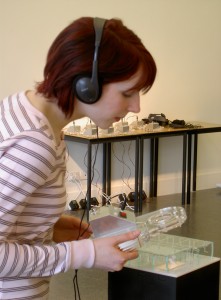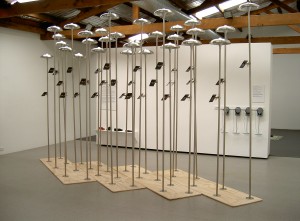Imagine a child of the ‘jet-age’ in an unobtrusive coastal village living mid-way between the dwelling of Blake, the artist, poet and visionary and that of his friend, the scientist and astronomer Halley. With eyes wide open to technics and ears tuned to poetics come some brief reminiscences……

The Naughty Apartment: An induction loop audio sculpture. RMIT Project Space, Melbourne, October 2003
The locus of motorcycle sensation is mapped on the forehead by the night’s wind, its constant pressure the companion of velocity. Beneath and slightly behind, a mechanical stream of sound embalms the rider and defends him from all exterior interruption. Ahead, a cone of yellow light reveals a fluid topography of space delivering but a scant and unconvincing rendition of motion. The middle ear and forehead are the active centres of this moving sphere, contracted in the velvet blackness of a Sussex night.
The Black dog is breathing its way forward, drawn along by the plumes of its own breath, plumes that scorch the air of the frozen shoreline. This breath has me in tow, as a subject of chemical interests that survive even this iron frost. The Black Dog and I move in nebulae of common exhalations and inhalations, aware of nothing beyond the black muzzle, the intense cold, negating all other sensation. My eyes merely observe the dog’s trajectory over the brittle white surface, my hearing turned inwards seeking circulatory sounds. Suddenly the voice of an ice floe slowly exploding in the solid ocean, the sound of an event so frigid that even time can barely move. No ordinary sound but an exposition of how frozen seawater speaks when rent apart by gravity and flux. For a moment the world opens and I am able to inhabit the interstice created within the floe and feel the transient warmth of chemical friction. The Black Dog continues intent on reclaiming the billowing traces of its breath.
To become truly blind – and in an attempt to see, that, which is profoundly hidden, he switches off the headlamp and accelerates. This is more realistic than momentarily closing the eyes. The exhaust changes pitch to match the increased wind pressure and he begins to count slowly until a vortex of fear overcomes the reverie. Startled eyes reconfirm the ground, verticality and trajectory – beyond the globe of sound and cone of light; the world is still in place.
We are in a dense embrace, drawn forward on a flow of molten lead. The air clings to every surface simultaneously penetrating the woven fibres of the sail and the recesses of our lungs – there is no distance, here all is co-substantial. The air is opaque, a milky smothering, embalming the chalk cliffs ahead, suffocating vision, muffling ears. Somewhere the ocean voices an argument with the cliff-face and somewhere a bell is drowning upon slow undulations.

Haiku: A solar powered digital audio sculpture. Boutwell-Draper Gallery, Sydney October 2003
1968 marked the inevitable point where the certainties of childhood no longer proved serviceable in a world of violent flux. A world those many mouths whispered that a beach had been discovered beneath the pavé of Paris and that the hottest spot in L.A. was no longer 77 Sunset Strip but the inferno of trashy Watts.
During the televised Apollo moon landing my mother had ceased her knitting to gaze at the screen with incredulity. After a cursory appraisal of the blurred moonscape, she wisely cautioned me not to be duped by such shabby Hollywood fantasies. For her the flag, permanently unfurled, to compensate for the absence of lunar wind and the clumsy puppet like motions of the ‘actors’ failed even as convincing science fiction.
Only later did I begin to appreciate the unintentional significance of her words, which recognised all transmissions as fiction. Ironically, it was I who struggled to accept the authenticity of the small voice, which inhabited my ear when we spoke to one another across the globe. The whispered mother voice of my childhood surely did not belong in this material world.
Scene #1 – Using the zoom facility it is possible to scrutinise the most intimate details of the performers. The watery blue eyes of the visitor gaze into the flickering blue viewfinder. The screen reveals the concrete plaza of a hotel, a fire burns, centre mid-ground, around this miniature figures shuffle indifferently to a monotonous rhythm.
This drama, viewed at right angles and in mono-chrome, will be premiered in the near future – on a cold winters night in Western Europe – on which occasion voyeurism will masquerade as ethnography and comprehension will be replaced by the digital memory.
Scene #2 – The driver of the low-rider pick-up truck indicates the direction. He is carrying more people than a luxury bus. 300 metres from the hotel on a dusty roadside lot a massive explosion of light and sound transforms the slumber of the mountain top town into a glowing crucible. The Cyclops eye of a robot disco lamp burns deep patterns on the retina as it pumps to the drum machine sequences, which invade the limbs of everyone within range. Hill-tribe women grin as they jangle the silver rupees of their head-dresses, adolescent boys armed with 12 gauge riot guns lurch up and down and children swarm in and out of the pay turnstiles after each clip of three tracks. Melody lines are vaguely western, lyrics in Thai, the jokes behind are Chinese, some transactions in Burmese and wry comments in Akha, Lisu and Lahu. Up in his tower the Imam cries out to the crystal night sky but only Burmese insurgents and a couple of U.S.D.A. agents hear his call – everyone else is too busy!
Nigel Helyer
Nigel Helyer (a.k.a. Dr Sonique) is an Australian based Sculptor and Sound Artist with an international reputation for his large scale sonic installations, environmental sound sculpture works and new media projects. Nigel is current recipient of an Australia Council and ARC ‘Synapse’ Linkage grant, working in collaboration with the Human Computer Inferface Lab, School of Computer Science at University of NSW.
Read More
 This work is licensed under a Creative Commons Attribution-NonCommercial-ShareAlike 3.0 Australia.
This work is licensed under a Creative Commons Attribution-NonCommercial-ShareAlike 3.0 Australia.






